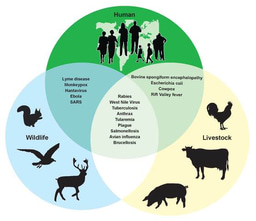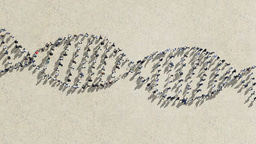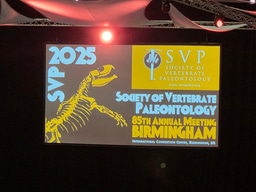Celebrating DNA Day with transposable elements
Published in Genetics & Genomics

The discovery of DNA’s double-helix structure by Watson, Crick and Franklin in 1953 laid the groundwork for understanding the molecular basis of heredity. In the same decade, Barbara McClintock suggested that genes in the maize genome could be controlled via unstable mutations that seemingly moved within and between chromosomes, and named these units controlling elements1. Initially dismissed, this view shifted in the 1960s and 1970s, when mobile elements and interspersed DNA repeats started to be found in bacteria and other organisms. By the 1970s, Britten and Davidson proposed that these elements could influence gene expression and reshape gene regulatory networks2,3. Nevertheless, repeats were generally overlooked and termed as “Junk DNA” (first coined by Ohno4). As discrepancies between genome size and organismal complexity emerged, research suggested that genomes contained more DNA than necessary to encode the full set of proteins5. It is now widely accepted that TEs contribute massively to genome size variation. Ranging from mere percentages of the genome, TEs easily occupy more than 50% of the DNA of many eukaryotic genomes6, up to an astonishing 90% in the lungfish7.
In the 1980’s, the idea of TEs as “selfish genes” gained traction, thanks to Doolittle & Sapienza8, and Orgel & Crick9. Along with the “junk DNA” premise, these hypotheses consider that the presence of TEs is solely due to their selfish nature. This perspective, coupled with technological limitations discouraged deeper exploration of TE functions for many years10. The tide began to turn in the early 2000s with the human genome draft revealing that nearly half of our genome consists of TE sequences, most of them remnants from ancient transposition events11. The outcomes of the Encode project12, along with the development of functional genomics and bioinformatics13, finally allowed the field to grasp TE potential functions. TEs can contain all the coding and regulatory sequences necessary for producing their transpositional machinery, including promoter sequences, transcription factor binding sites, splicing and poly(A) sites, along with functional open reading frames14–16. The presence of such sequences, even in decayed copies, has been recurrently involved in the modulation of host pathways, in some instances effectively rewiring gene regulatory networks17,18. However, while it is now undeniable that many TE-derived sequences play a beneficial role in host biology, it is important to remember that most new observed TE insertions are either neutral or slightly deleterious19.
Beyond species-level effects, we are finally harnessing the importance of strain or even individual-specific TE insertions. For instance, active TE families in humans may account for more than ~2000 structural variants per individual20,21. The magnitude of individual variation brought on by TEs, along with their intrinsic regulatory sequences and therefore potential for domestication is tremendous. Today, the field moves towards acknowledging TE polymorphisms between populations and within populations, but also within an individual, with somatic and potentially age-related new TE insertions22–24. Finally, today we acknowledge that the TE relationship with their hosts ranges from parasitic to domesticated25,26.
References
1.McClintock, B. Chromosome Organization and Genic Expression. Cold Spring Harb Symp Quant Biol 16, 13–47 (1951).
2.Britten, R. J. & Davidson, E. H. Repetitive and Non-Repetitive DNA Sequences and a Speculation on the Origins of Evolutionary Novelty. The Quarterly Review of Biology 46, 111–138 (1971).
3.Britten, R. J. & Davidson, E. H. Gene Regulation for Higher Cells: A Theory. Science 165, 349–357 (1969).
4.Ohno, S. So much “junk” DNA in our genome. Brookhaven Symp Biol 23, 366–370 (1972).
5.GREGORY, T. R. The C-value Enigma in Plants and Animals: A Review of Parallels and an Appeal for Partnership. Annals of Botany 95, 133–146 (2005).
6.Wells, J. N. & Feschotte, C. A Field Guide to Eukaryotic Transposable Elements. Annu Rev Genet 54, 539–561 (2020).
7.Meyer, A. et al. Giant lungfish genome elucidates the conquest of land by vertebrates. Nature 1–6 (2021).
8.Doolittle, W. F. & Sapienza, C. Selfish genes, the phenotype paradigm and genome evolution. Nature 284, 601–603 (1980).
9.Orgel, L. E. & Crick, F. H. C. Selfish DNA: the ultimate parasite. Nature 284, 604–607 (1980).
10.Feschotte, C. Transposable elements: McClintock’s legacy revisited. Nat Rev Genet 24, 797–800 (2023).
11.Lander, E. S. et al. Initial sequencing and analysis of the human genome. Nature 409, 860–921 (2001).
12.Dunham, I. et al. An integrated encyclopedia of DNA elements in the human genome. Nature 489, 57–74 (2012).
13.Bourque, G. Transposable elements in gene regulation and in the evolution of vertebrate genomes. Curr Opin Genet Dev 19, 607–612 (2009).
14.Chuong, E. B., Elde, N. C. & Feschotte, C. Regulatory activities of transposable elements: from conflicts to benefits. Nat Rev Genet 18, 71–86 (2017).
15.Rebollo, R., Romanish, M. T. & Mager, D. L. Transposable elements: an abundant and natural source of regulatory sequences for host genes. Annu. Rev. Genet. 46, 21–42 (2012).
16.Bourque, G. et al. Ten things you should know about transposable elements. Genome Biol 19, 199 (2018).
17.Chuong, E. B., Elde, N. C. & Feschotte, C. Regulatory evolution of innate immunity through co-option of endogenous retroviruses. Science 351, 1083–1087 (2016).
18.Sundaram, V. & Wysocka, J. Transposable elements as a potent source of diverse cis-regulatory sequences in mammalian genomes. Philos Trans R Soc Lond B Biol Sci 375, 20190347 (2020).
19.Arkhipova, I. R. Using bioinformatic and phylogenetic approaches to classify transposable elements and understand their complex evolutionary histories. Mobile DNA 8, 19 (2017).
20.Sudmant, P. H. et al. An integrated map of structural variation in 2,504 human genomes. Nature 526, 75–81 (2015).
21.Groza, C., Chen, X., Wheeler, T. J., Bourque, G. & Goubert, C. A unified framework to analyze transposable element insertion polymorphisms using graph genomes. Nat Commun 15, 8915 (2024).
22.Le Breton, A., Bettencourt, M. P. & Gendrel, A.-V. Navigating the brain and aging: exploring the impact of transposable elements from health to disease. Front. Cell Dev. Biol. 12, (2024).
23.Copley, K. E. & Shorter, J. Repetitive elements in aging and neurodegeneration. Trends in Genetics 39, 381–400 (2023).
24.Mosaddeghi, P., Farahmandnejad, M. & Zarshenas, M. M. The role of transposable elements in aging and cancer. Biogerontology 24, 479–491 (2023).
25.Cosby, R. L., Chang, N.-C. & Feschotte, C. Host–transposon interactions: conflict, cooperation, and cooption. Genes Dev. 33, 1098–1116 (2019).
26.Chang, N.-C., Rovira, Q., Wells, J., Feschotte, C. & Vaquerizas, J. M. Zebrafish transposable elements show extensive diversification in age, genomic distribution, and developmental expression. Genome Res. 32, 1408–1423 (2022).
Follow the Topic
-
Mobile DNA

Mobile DNA is an online, peer-reviewed, open access journal that publishes articles providing novel insights into the function, biological impact, and evolution of transposable elements in any organism.
Related Collections
With Collections, you can get published faster and increase your visibility.
Mobile DNA Tools
Repository for all published articles on softwares, databases, and methodologies. Submit your updates and new submissions on not yet covered databases and other tools for analyzing and categorizing transposable elements.
This collection has been peer reviewed by the journal's Editorial Board.
Publishing Model: Open Access
Deadline: Ongoing
All Reviews Collection
Repository for all published Review articles. Contributions from some of the leading researchers working with mobile DNA.
This collection has been peer reviewed by the journal's Editorial Board.
Publishing Model: Open Access
Deadline: Ongoing





Please sign in or register for FREE
If you are a registered user on Research Communities by Springer Nature, please sign in